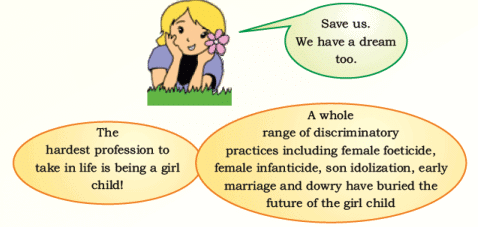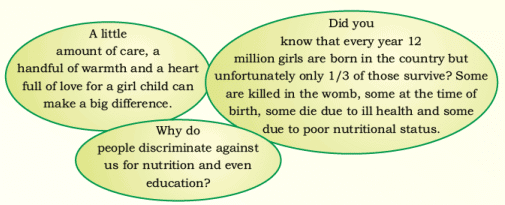Educating The Girl Child NCERT Solutions | Communicative English for Class 10 PDF Download
B.2. Working in pairs, answer the following questions :
- Name two states with the lowest female literacy.
- Name two states with the highest female literacy.
- Name two states that rank second in female literacy.
Ans:
- Jharkhand and Bihar
- Kerala and Mizoram
- Delhi and Goa
B.3. What do you think are the causes for female illiteracy in India ?
Ans:
- superstitions
- ignprance
- poverty
- traditions
- dowry
- male-dominated society
- attitude towards women
Ans: Students to read the text on their own as desired.
B.5. On the basis of your reading of the story and the discussion between the girls in the following picture, have a w
hole class discussion on-The Need to Recognize and Empower the Girl Child.


Some more information relating to the subject is given below to help in the discussion :
Present situation of the girl child—the negative side
- birth of a girl child not received well because of various beliefs, customs and traditions like dowry, a burden on parents – financially etc. – dependent, weaker sex etc.
- practices like female foeticide, female infanticide, son idolization, girl not seen as the propagator of one’s dynasty, etc.
- girl child education a drain on one’s parents, treated a burden till married off.
- an object of consuming, of sex only, and not an equal partner in the drama of life but as a propagator of one’s dynasty
Changed scenario—the positive side
- women breaking the age-old shackles of superstitions, dowry, being weaker sex- emerging as more than equal men in various fields of life.
- women now engineers, entrepreneurs, business tycoons, pilots, army officers, planners etc, have proved as efficient, honest officials.
- have proved their worth not less than that of men in terms of skills, intelligence, hard work, endurance, mental and physical strength.
- scene changing now—female-dominating families—compulsory education for girl child
- opening of more girl schools, colleges, universities due to govt planning for girl children and their indispensability for human survival programmes like Sarva Shiksha Abhiyan and its provisions real tools for the education, upliftment of girl child.
- women now on the forefront in every field of human activity-albeit more than men.
B.6. Read the following extract on Girl Child Education
Ans: Students to read the text on their own.
B.7. On the occasion of Women’s Day, your school Literary Club organizes a Speech Competition on the topic-“Empowering the Girl Child is the Best Way to Empower the Nation.” On the basis of the input given above and your own ideas, draft the speech.
When giving your speech :
- Stand
- Make sure you look at every member of your audience while speaking
- Use questions, so as to involve your audience e.g. “Did you know that ………. ?” “I wonder how many of you are aware ……… ?”
- Speak up so that everyone can hear you
- Pause occasionally
- Don’t talk too fast
Ans: Worthy judges, teachers and dear students
Today I, Shruti, stand before you to speak on “Empowering the Girl Child is the Best Way to Empower the Nation” on the occasion of Women’s Day today.
I submit that a woman sits at the centre of a family. If she is educated and enlightened about everything she can take the family forward socially, economically and, of course, morally. You’ll see that if a family progresses this way, a district progresses, a state progresses and, finally, the country progresses.
You’ll agree with me that such a stage of complete progress due to a woman is yet to be gained. However, I feel strongly that we have discarded many age-old superstitions and beliefs against a girl child, like she is a burden etc. Discrimination against a girl child still takes place in villages but not much in cities. Then there is a whole range of discriminatory practices. These are female foeticide, female infanticide, son idolization, early marriage and dowry. Girls are not seen as the propagators of one’s dynasty.
But as the time passes such things are left behind. You’ll agree with me if I say that today women are not behind men in any way. There are women entrepreneurs, pilots, doctors, army officers, planners, politicians and what not. They have truly shown their worth by their sincerity, dedication and devotion. It is all due to government policies like Sarva Shiksha Abhiyan or ‘Education for AH’. Today’s woman has woken up to her rights and responsibilities. I wonder how many of you are aware that we have had amongst us the most powerful women in the world in Smt. Pratibha Singh Ex-President, and Smt. Sonia Gandhi as ex-chairperson of UPA ! But much is to be done though we have more girl schools, colleges, universities etc. Since women are equal partners in every way, they need to be recognized as indispensable and equal. Their being empowered will mean empowering the nation.
Thank you very much.
B.8. Girls’ Enrolment:
Ans: Students to study the data and understand it.
B.8. Did you note that in spite of the Government’s initiatives and provisions made for the girl child, the statistics shown in the enrolment position of girls in primary and upper primary are not very encouraging. Write a letter to the editor of a national daily, expressing your concern about the issue and the need to work on a war footing to counter the problem of poor enrolment of girls.
Ans:
24th September, 20 – –
The Editor
The Times of India
New Delhi
Subject : Problem of poor enrolment of girls in schools and suggestions thereof
Dear Sir
Kindly publish the following views of mine on the problem of poor enrolment of girls in primary and upper primary in the appropriate columns of your esteemed daily.
It is sad that we have not yet been able to ensure gender parity in the field of education despite our best efforts. The data available showing the enrolment of girls in primary and Upper primary have not been much encouraging. For instance, during the years 1999-2001, not much percentage was seen. In the year 2001-2003 there was a slight increase from 44.2 to 46.8 in primary and from 41.7 to 43.9 in the upper primary. Then in the years 2003-2005 there was slight increase only.
From this it is clear that the age-old beliefs about the girl child as a burden on parents still grip the minds of the parents. For this dowry, son idolization etc, are more responsible than any other reasons. We need social workers to eradicate such stupid beliefs from the minds of the parents. If we want to bring dynamic changes in the mindset of the people, girls should be educated. Their education holds the key to a large number of problems. The education of girls means the education of a whole family. The empowerment of women through programmes like Sarva Shiksha Abhiyan is needed the most. Old centres of power of men stand now invaded by women.
But not much has been done. There is still a need of awakening about what women can do to fight the bias against girls. These are like reservation of women in seats of power. So all govt, and non-govt, agencies need to work on a war footing to counter the problem of poor enrolment of girls.
Thanking you
Yours faithfully
____________
|
8 videos|250 docs|8 tests
|
FAQs on Educating The Girl Child NCERT Solutions - Communicative English for Class 10
| 1. What are the main reasons for educating the girl child? |  |
| 2. How does educating girls impact society as a whole? |  |
| 3. What challenges do girls face in accessing education? |  |
| 4. What role do governments and NGOs play in promoting girls' education? |  |
| 5. How can individuals contribute to the education of the girl child? |  |
















